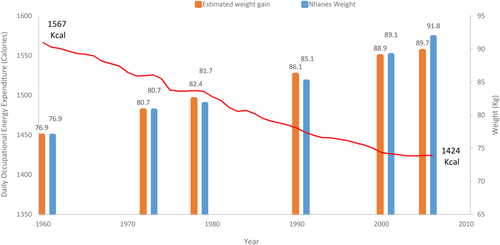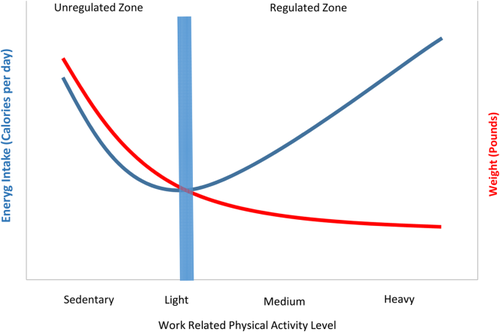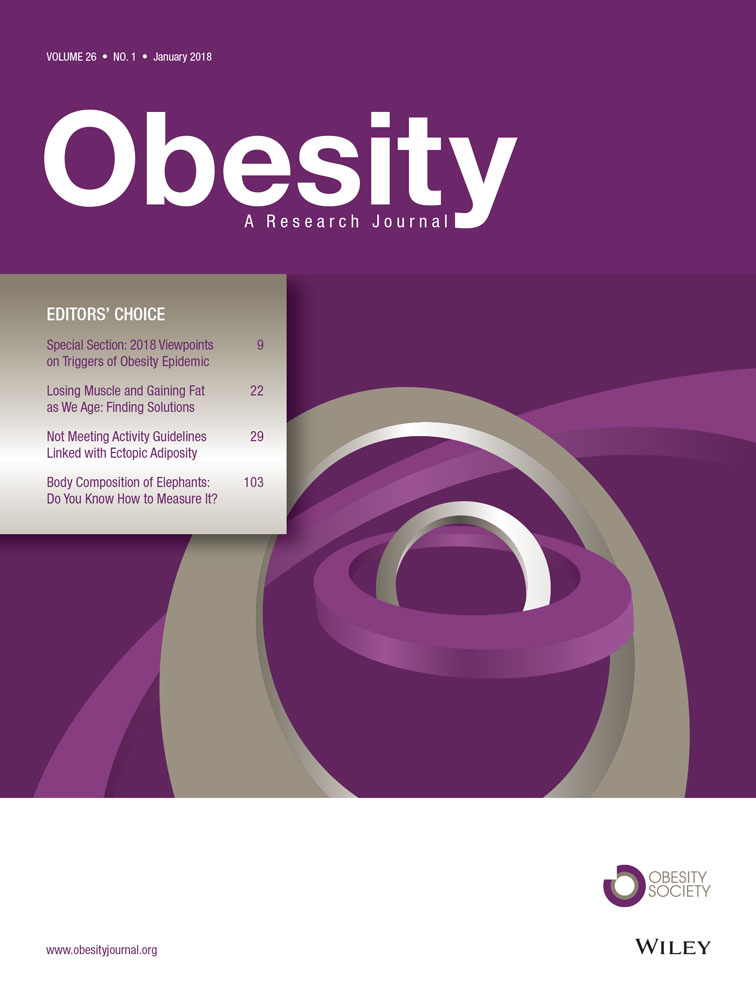The Obesity Epidemic: A Consequence of Reduced Energy Expenditure and the Uncoupling of Energy Intake?
Disclosure: The authors declared no conflict of interest.
Abstract
Obesity prevalence has increased, and increased energy intake or decreased physical activity are the two most obvious contributing factors. The percentage of Americans engaging in exercise has been stable over the past few decades, but decreases in occupation-related energy expenditure are sufficient to partially explain increased obesity prevalence. Further, the contribution of energy intake and energy expenditure to the obesity epidemic is complicated because they are not independent—they are influenced by each other. For example, Mayer found that low activity levels were marked by higher body weight and higher “unregulated” energy intake levels. Conversely, higher activity levels were marked by lower body weight and energy intake that matched energy expenditure. Consistent with Mayer, we propose that because most Americans have low levels of occupation-related activity, they do not benefit from the regulation of energy intake achieved at higher activity levels, resulting in weight gain due to energy intake exceeding energy expenditure.
There are three distinct phases in the weight gain–loss continuum: initial weight gain, weight loss, and weight loss maintenance. The underlying physiology of each phase is unique, including the relative contribution of energy intake and energy expenditure. Of the three phases, weight loss is the best understood, with caloric intake having a much larger influence on active weight loss than exercise (1). For weight loss maintenance, it is widely stated that regular exercise is critical to keeping weight off after the active weight loss phase (2). The data supporting this assertion are largely post hoc, and to date, there have been no large properly powered trials that have specifically examined the role of exercise in helping to maintain weight loss. We have demonstrated that, in many individuals, increased exercise results in increased energy intake, a phenomenon known as compensation (3). From a clinical perspective, there is a great need to better identify individuals who will negatively respond to increased exercise and concomitant increases in energy expenditure.
The least understood of the three phases of the weight gain–loss continuum is the weight gain phase. This lack of understanding is surprising, given the importance of avoiding weight gain in the first place, as it is very clear that once weight is gained, the human body will physiologically defend the new weight (4). The popular consensus is that the increase in the variety, availability, and caloric density of the food supply has driven population-wide increases in caloric intake and the obesity epidemic in general (5). Given the plethora of best-selling books, media coverage, and obviousness of this argument, it is not hard to appreciate how this has become a generally accepted belief. However, the longitudinal data to support the food supply characteristics driving the obesity endemic are remarkably weak, particularly given the magnitude of public health importance this issue presents.
The relative contribution of changes in physical activity to the obesity epidemic is largely dismissed because of the undeniable observation that the percentage of Americans participating in regular exercise has not changed over the past few decades (5). However, this dismissive argument ignores the fact that formal exercise plays a very small role in the total daily physical activity energy expenditure. Total energy expenditure is driven by total daily activity, which is primarily determined by occupation.
The federal government tracks yearly the types of jobs Americans fill, and the Occupational Safety and Health Administration does a remarkable job of assigning energy expenditure requirements to all jobs. We took advantage of these data sources to examine how trends in work-related physical activity and energy expenditure from 1960 to 2006 have impacted population-wide weight gain (6). We observed that in the 1960s, 50% of individuals had a job that required a level of physical activity that would meet the current daily physical activity goals (Figure 1). We estimated that by 2006 less than 20% of Americans had jobs that required this level of physical activity. And this is likely a large underestimation, as we were not able to take into account technological efficiencies in this analysis and only focused on job categories. We estimated a progressive loss of 100 to 150 calories per day, and this reduction in energy expenditure produced an estimated population-based weight gain that closely matched the National Health and Nutrition Examination Survey's measured weight over the years (Figure 1). We are not the first to demonstrate that a relatively small change in energy balance could explain the obesity epidemic (7). We appreciate that our findings are provocative, and it is very important to point out that we do not believe that work-related physical activity is entirely responsible for the obesity epidemic. The primary point is that it is unlikely that changes in the food supply can alone account for the obesity epidemic, and changes in daily activity are likely an important part of this conversation.

The red line represents the decrease in daily occupational energy expenditure from 1960 to 2010 for men. The orange bars represent the expected mean body weight of men in the United States based on decreases in energy expended via occupations. The blue bars represent the mean body weight for men from the National Health and Nutrition Examination Survey. Adapted from Church et al. (6).
As noted earlier, energy expenditure and energy intake are not independent physiological systems but rather are intimately connected. From an evolutionary perspective, it makes sense that there is a strong physiological drive to match caloric intake to caloric expenditure. This is supported by Bassett et al.’s study of an agrarian Amish community in which it was observed that high levels of work-related physical activity were accompanied by high levels of energy intake but very low levels of obesity (8). The very high levels of daily energy expenditure of the Amish population did not allow for examination of energy intake in sedentary subgroups. Mayer et al. studied the associations of work-related physical activity, weight, and energy intake across a wide range of activity levels (9). They too found that at moderate-high levels, energy expenditure closely matched energy intake and that there was a low prevalence of overweight in these individuals. Conversely, at low levels of energy expenditure, the association between energy expenditure and energy intake were disrupted, with high levels of energy intake accompanying low levels of activity and elevated weight. As depicted in Figure 2, Mayer et al. proposed a J-shaped association between energy expenditure and energy intake, in which energy intake matches energy expenditure at higher levels of energy expenditure. But at low levels of energy expenditure, this tight association is disrupted and high levels of energy intake persist, resulting in weight gain.

The blue line represents the J-shaped association between energy expenditure and energy intake in which energy intake matches energy expenditure at higher levels of energy expenditure but not at lower levels of energy expenditure. The red line represents body weight. At high levels of energy expenditure, weight is controlled because of the relation between energy expenditure and energy intake. At low levels of energy expenditure, however, weight is increased because of higher levels of energy intake in the context of low levels of energy expenditure. Adapted from Mayer et al. (9).
We propose that the current very low levels of occupation-related physical activity have pushed the majority of Americans into the unregulated zone of Mayer's curve. And this, combined with the modern food environment, has created a toxic interaction responsible for the current obesity epidemic.
Given the body's resistance to weight loss once weight is gained, the importance of preventing weight gain cannot be overstated. There is a critical need to better understand the broader determinants of weight gain. Focusing only on food intake, while ignoring energy expenditure, minimizes the complexity of the biology of weight gain and ultimately delays the development of truly successful approaches.





